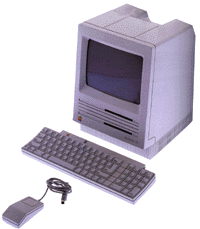Corporate focus: 1986-89
Part 2 - Corporate Snow White
4-frogdesign || 5-Corporate focus || Conclusion || Bibliography & links
![]()
![]()
The Macintosh would finally
receive the Snow White treatment at the end of 1986 with the
simultaneous introduction of two new products, the SE and
the Macintosh II. Both these machines reflected
Gassée's desire to open the Macintosh architecture to
internal expansion. The Plus had
provided a SCSI port for external devices, but Gassée
believed that an internal hard drive and the capacity for
more expansion were expected in corporate settings
(Carlton, 27). Some
users had rebelled against the Mac's closed architecture,
and products appeared as early as 1984 which required
circuitry modifications that voided their warranties
(Levy, "Shut and
Open," 55). Unlike Jobs, who considered accessibility to the
circuitry to be unnecessary and undesirable, Gassée
supported his engineers' interest in making the Macintosh
expandable and even had license
plates on his car which read "openmac"
(Carlton, 47).
license
plates on his car which read "openmac"
(Carlton, 47).
The powerful appearance of the
Macintosh II and the serious facade of the SE represent the
conscious movement of Apple away from the friendly, even
playful, appearance of its earlier machines. Before these
products, the Mac had not been regarded as a viable business
tool, but as a toy
(Levy, 196). Its
appearance, referred to countless times in various magazines
as "cute," did not appear to detract from its acceptance by the emerging
desktop publishing industry and graphic designers. However,
the industrial appearance of the PC seemed to have emerged
as the only acceptable design for corporate environments; it
had, after all, emerged from IBM, then one of the most
respected of American corporations. In 1984, the technology
columnist John Dvorak could already express the
crystallizing expectation of users for this physical
standard: unlike the friendly Macintosh which made
technology universally accessible, the IBM PC is "a man's
computer designed by men for men"
(Gelernter, 40).
To position its products towards this lucrative corporate
market, Apple had to adjust towards this expectation for a
particular form. The physical expression of their friendly
and accessible graphical interface became diluted when
reshaped into the standard.
acceptance by the emerging
desktop publishing industry and graphic designers. However,
the industrial appearance of the PC seemed to have emerged
as the only acceptable design for corporate environments; it
had, after all, emerged from IBM, then one of the most
respected of American corporations. In 1984, the technology
columnist John Dvorak could already express the
crystallizing expectation of users for this physical
standard: unlike the friendly Macintosh which made
technology universally accessible, the IBM PC is "a man's
computer designed by men for men"
(Gelernter, 40).
To position its products towards this lucrative corporate
market, Apple had to adjust towards this expectation for a
particular form. The physical expression of their friendly
and accessible graphical interface became diluted when
reshaped into the standard.
Macintosh SE (1986) Macintosh II (1986) Macintosh IIcx (1989)
Home || Introduction || Historiography || 1-Cottage industry || 2-Emerging standards || 3-Macintosh
4-frogdesign || 5-Corporate focus || Conclusion || Bibliography & links







.jpg)








